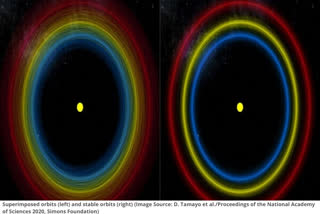Washington D.C.: "Separating the stable from the unstable configurations turns out to be a fascinating and brutally hard problem," said Daniel Tamayo, a NASA Hubble Fellowship Program Sagan Fellow in astrophysical sciences at Princeton.
To make sure a planetary system is stable, astronomers need to calculate the motions of multiple interacting planets over billions of years and check each possible configuration for stability -- a computationally prohibitive undertaking.
Astronomers since Isaac Newton have wrestled with the problem of orbital stability, but while the struggle contributed to many mathematical revolutions, including calculus and chaos theory, no one has found a way to predict stable configurations theoretically.
Modern astronomers still have to 'brute-force' the calculations, albeit with supercomputers instead of abaci or slide rules.
Tamayo and his colleagues realized that they could accelerate the process by combining simplified models of planets' dynamical interactions with machine learning methods.
Also Read: Google AI and ML translation services are providing COVID-19 information in 350 languages
This allows the elimination of huge swaths of unstable orbital configurations quickly -- calculations that would have taken tens of thousands of hours can now be done in minutes.
He is the lead author on a paper detailing the approach in the Proceedings of the National Academy of Sciences. Co-authors of the new study include David Spergel, director of the Flatiron Institute's Center for Computational Astrophysics (CCA) in New York City, as well as CCA group leaders Phil Armitage and Shirley Ho.
"Despite centuries of effort, the mechanisms that drive planetary systems unstable remain debated," Armitage said.
The new work "demonstrates that by combining our hard-won understanding of planetary dynamics with modern machine learning techniques, we can reliably predict the fate of an abundant class of known extrasolar planetary systems.
Also Read:Features and specifications of Canon EOS R5 and Canon EOS R6 cameras, launched in India
" For most multi-planet systems, there are many orbital configurations that are possible given current observational data, of which not all will be stable. Many configurations that are theoretically possible would 'quickly' -- that is, in not too many millions of years -- destabilize into a tangle of crossing orbits. The goal was to rule out those so-called 'fast instabilities.'
"We can't categorically say 'This system will be OK, but that one will blow up soon,'" Tamayo said. "The goal instead is, for a given system, to rule out all the unstable possibilities that would have already collided and couldn't exist at the present day.
" Instead of simulating a given configuration for a billion orbits -- the traditional brute-force approach, which would take about 10 hours -- Tamayo's model instead simulates for 10,000 orbits, which only takes a fraction of a second.
